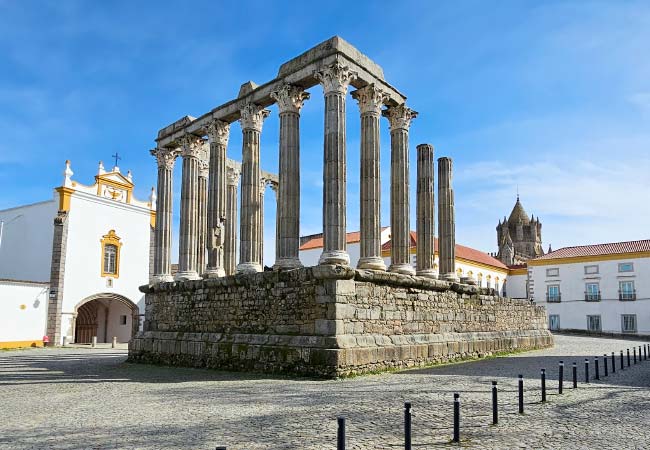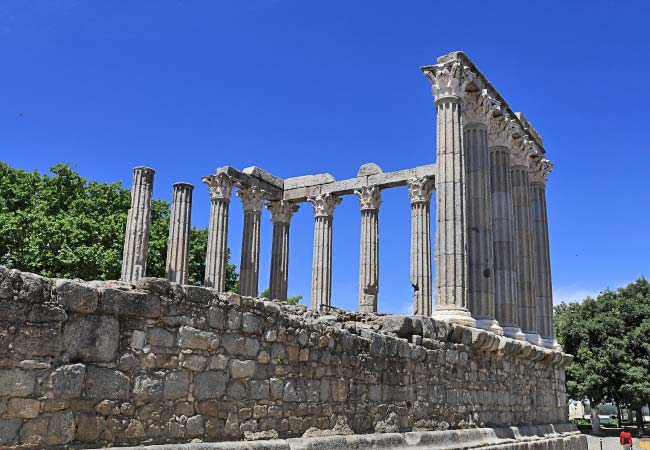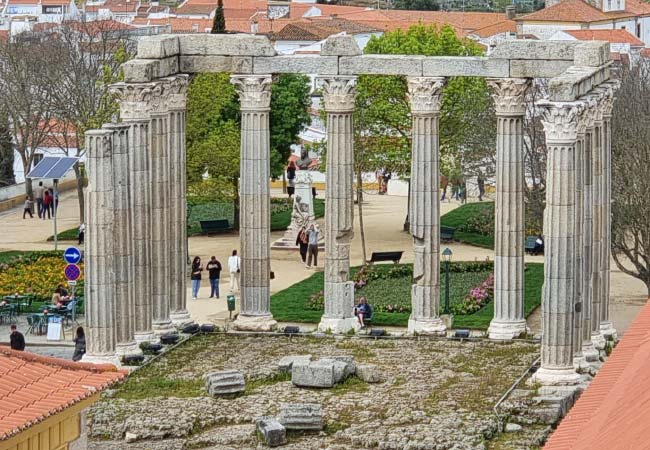MyPortugalHoliday.com
The best independent guide to Central Portugal
MyPortugalHoliday.com
The best independent guide to Central Portugal
The Roman Temple of Évora
Standing at the highest point of Évora is a magnificent Roman temple, with it’s 12 ancient columns dating back over 2,000 years.
The temple is regarded as the best-preserved Roman structure on the Iberian Peninsula, owing its survival to fortunate events. Over the centuries, it was incorporated into various buildings - first as part of Évora Castle, then as an abattoir, and finally as a humble wood store.
During the Roman era it was an impressive sight - 25 meters long by 15 meters wide with a raised plinth - made it the key structure of Roman Évora. Originally, the temple featured columns on three sides and a wide staircase entrance spanning the entire south side. The temple’s prominent position reflected its importance in Roman Évora, while the construction of a temple demonstrated the significance of Evora within the Roman empire.

Today the temple's most striking feature are its 12 Corinthian columns, which remain standing with their connecting architraves fully intact. The temple's granite columns rise an impressive 7.68 meters (25 feet) high, and their Corinthian capitals feature intricate acanthus leaf designs typical of Roman architectural decoration.
The marble used in parts of the temple was quarried locally, showing how Roman builders adapted to use regional materials. Its elegant Corinthian columns feature carved decorations with delicate flower motifs, including marigolds, sunflowers, and roses.
While often called the Temple of Diana, the temple wasn't actually dedicated to Diana the hunting goddess, during the Roman era. Instead, evidence suggests it was likely devoted to the imperial cult of Augustus, reflecting the Roman practice of emperor worship. The connection to Diana only emerged in the 17th century through a story created by a local priest.

History of the Roman Temple in Evora
Built in the 1st century, the temple was built to honour Emperor Augustus, who was worshipped as a god during and after his reign. The temple suffered significant damage in the 5th century during invasions by Germanic tribes, who swept through the Iberian Peninsula
During the 11th century, the temple became part of Évora Castle, with its base, columns, and architraves incorporated into the medieval tower's walls. Later, when the structure was converted into a medieval butcher's shop, brick walls were added between the columns. These walls, while concealing the temple's original classical architecture, proved crucial in protecting the columns from collapse or damage for several centuries.
In 1467, King Afonso V even granted permission for stones from the temple to be removed for building projects and defence works. Despite this, the structure survived, and by 1789, architect James Murphy created the first detailed reconstruction of how the temple originally appeared.
The temple's true significance was rediscovered in 1836, leading to an extensive restoration project. Under Giuseppe Cinatti's direction, the medieval brickwork was carefully removed, with work completing in 1871. The temple's historical significance was formally recognized when UNESCO declared it a World Heritage site in 1986.

Evora Temple Tourist Information
You'll find the temple in the Largo Conde de Vila Flor square. Thanks to its location at the city's highest point, it's easy to find - simply walk uphill. The temple is accessible 24 hours a day and there is no entrance fee.
Visitors can take in the temple's majestic columns and architectural details while walking around its perimeter. The site offers excellent opportunities for photography, particularly during sunrise and sunset when the ancient stone glows in the golden light.
The surrounding area offers additional attractions, including the Jardim de Diana gardens, the Palácio da Inquisição, and the Museum of Évora, all nestled beneath the imposing Sé Cathedral.


























